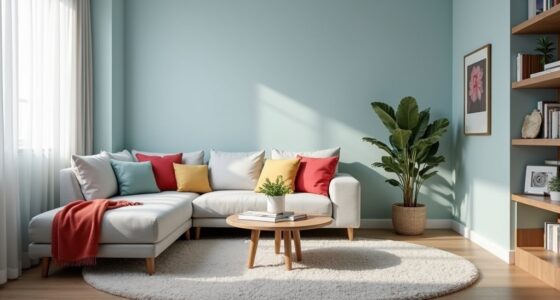To measure your space for a new sofa or bookshelf, start by measuring the room’s length, width, and wall height. Don’t forget to check doorways and hallways to guarantee your new furniture can fit through. Sketch a simple floor plan, marking fixed features like windows and doors. Use painter’s tape to visualize furniture placement and make sure there’s enough clearance. This process helps avoid surprises during delivery, and you’ll find more tips to make it even easier.
Key Takeaways
- Measure the length, width, and height of the room using a metal tape measure to ensure proper fit for the sofa or bookshelf.
- Check the dimensions of doorways and hallways to confirm that furniture can be moved into the space without obstruction.
- Create a simple floor plan, marking fixed features like windows and doors to visualize the best arrangement for new furniture.
- Use painter’s tape on the floor to outline the dimensions of the sofa or bookshelf, ensuring it fits well within the designated area.
- Leave at least two feet of clearance around key furniture pieces for easy movement and accessibility in the room.
Preparing the Space for Your New Sofa or Bookshelf

Before you bring home that new sofa or bookshelf, it’s essential to prepare the space properly. Start by measuring the width and length of the designated area to guarantee your new piece will fit comfortably. Additionally, be mindful of smart shopping practices to find the best deals online. Don’t forget to measure the height of the walls, especially if you’re considering taller furniture. Clear the area of any existing items to create an unobstructed space for delivery and setup. To enhance the ambiance, consider incorporating cozy textiles that complement your new furniture. Decluttering the space beforehand can significantly improve your overall emotional well-being, making the transition smoother and more enjoyable.
To visualize how your new sofa or bookshelf will fit, use masking tape or newspaper to outline its dimensions on the floor. Remember to leave at least two feet of space around key pieces of furniture, maintaining a functional and open atmosphere while you’re measuring your space. Additionally, consider incorporating natural materials to enhance the overall aesthetic of your room.
Measuring Your Room Dimensions

To start measuring your room dimensions, grab a metal tape measure and check the length and width of the space. Don’t forget to measure the wall height, as this helps when planning for taller furniture. Additionally, smart appliances can enhance the functionality and aesthetic appeal of your space. Accurate measurements are key to making sure your new sofa or bookshelf fits perfectly. Furthermore, ensuring water efficiency in your bathroom fixtures can contribute to overall household savings. Additionally, consider how effective wall organization can enhance the functionality and aesthetic appeal of your space. Ensuring that your room has appropriate contrast ratios can further optimize the visual experience of your setup. Moreover, investing in best home security systems can provide peace of mind while you enjoy your new furniture.
Room Length and Width
Measuring your room’s length and width is essential for finding the perfect sofa or bookshelf. Start with a metal tape measure to guarantee accuracy. Follow these steps:
- Measure Length: Measure from one wall to the opposite wall at the longest points, excluding baseboards or trim.
- Measure Width: Do the same for the width, taking note of any fixed features like windows or doors that might affect furniture placement. Additionally, ensure your measurements comply with local building codes to avoid any issues with furniture size in smaller spaces. Consider how your measurements will fit with farmhouse charm elements, such as vintage furniture or natural materials. It’s important to also think about weather-resistant materials if you plan to use outdoor furniture inside, as it can add a unique touch to your decor.
- Record Dimensions: Write down the measurements for reference, including the wall height for taller furniture options. Additionally, consider the watering techniques for any indoor plants you plan to incorporate, as their placement may affect your furniture layout.
After measuring, sketch a simple floor plan to visualize your space. This will help you determine where your new furniture will fit best, assuring a balanced and functional layout. Additionally, consider how to prevent cats from scratching furniture to protect your investment if you have pets in your home.
Wall Height Measurement
Understanding your wall height is essential when planning for new furniture. To get accurate measurements, use a metal tape measure to measure the height from the floor to the highest point, accounting for any ceiling fixtures or moldings. Document the height in inches or centimeters for easy reference.
Consider the overall proportions of your room; a tall bookshelf works well with high ceilings, while a lower sofa can create an airy feel in spaces with limited height. If your room has sloped ceilings, measure the height at multiple points. This helps you choose pieces that fit well and don’t obstruct movement. Additionally, understanding toilet maintenance can provide insights into how your furniture choices might reflect your personal style and preferences. Proper clearances from combustibles are also crucial to ensure safety and efficiency when placing furniture near your heating sources.
Record all wall height measurements alongside other dimensions to aid in selecting and placing your existing furniture effectively. Additionally, considering energy efficiency ratings can help you choose furniture that complements the overall energy profile of your home.
Assessing Doorways and Hallways

How can you guarantee your new sofa or bookshelf fits through your home’s doorways and hallways? Start by measuring key areas to avoid delivery headaches. Follow these steps:
- Measure Doorways: Check the width and height of all doorways. Aim for dimensions that exceed your furniture’s width and diagonal height. Ensure that the suction power of any vacuum used to clean the area is sufficient to handle any debris that may obstruct the path. A well-organized space promotes a clutter-free environment, making it easier to navigate during delivery. Additionally, be aware that primitive weapons can be cumbersome and difficult to maneuver, similar to oversized furniture. Consider the filtration systems in your vacuum to ensure they can effectively capture any dust or allergens that may be present during the move.
- Assess Hallways: Measure the width and height of hallways leading to the intended room. Narrow or low hallways can complicate maneuvering.
- Check for Obstacles: Look for turns, corners, and fixed features like light fixtures or banisters that may impede the delivery path. Proper measuring techniques ensure a smooth delivery experience.
Double-check your measurements to prevent any surprises during delivery.
Even slight discrepancies can stop your new piece from entering the space you’ve designated for it.
Understanding Furniture Dimensions

Selecting the right sofa or bookshelf hinges on knowing their dimensions. When measuring, focus on three key measurements: width, depth, and height.
For sofas, measure the width from arm to arm, depth from the back frame to the front arm, and height from the floor to the highest point.
Bookshelves need similar attention; make sure you measure their depth and diagonal height accurately. Remember, diagonal measurements are vital for a successful delivery.
The diagonal depth of your sofa should be less than the width of your doorways and hallways. Always verify that the total dimensions, including any removable parts, fit comfortably within your space, allowing room for movement and accessibility.
This way, you’ll avoid any unpleasant surprises!
Creating a Floor Plan for Your Space

To create a functional floor plan, start by sketching your room’s layout, including the dimensions and fixed features like windows and doors.
This helps you visualize how your new sofa or bookshelf will fit in the space.
Don’t forget to leave enough clearance for easy movement around your furniture.
Visualizing Furniture Arrangement
When planning your furniture arrangement, have you considered how a well-thought-out floor plan can transform your space?
Visualizing furniture arrangement is essential for a successful selection of furniture. Start by measuring your space and marking the dimensions on graph paper or an online tool.
Here are three tips to enhance your floor plan:
- Include fixed features: Mark windows, doors, and radiators to avoid obstructing access.
- Outline dimensions: Use painter’s tape on the floor to visualize how your new sofa or bookshelf fits.
- Allow space for movement: Leave at least two feet around key pieces to maintain flow and prevent overcrowding.
With these steps, you’ll create a functional and inviting room.
Marking Features and Measurements
Creating an accurate floor plan is essential for successfully marking features and measurements in your space. Start by sketching a simple layout on graph paper or using an online tool. Measure the room’s dimensions, including the length, width, and height of the walls.
Be sure to mark fixed features like doors, windows, and radiators to visualize available space and avoid blocking access. Use a tape measure to note the distances between these features and the walls, which helps you identify ideal furniture placements.
Clearly label all measurements on your floor plan for reference during selection. Finally, utilize painter’s tape on the floor to outline the dimensions of your new sofa or bookshelf, aiding in evaluating room flow and functionality.
Visualizing With Tape and Paper

Visualizing the space your new sofa or bookshelf will occupy can be made easier with a few simple tools. Here are three effective methods to help you measure and visualize the space:
- Tape Outlines: Use masking tape or painter’s tape to outline the dimensions of your new furniture directly on the floor. This will give you a clear visual of how much space it will take up.
- Paper Footprints: Create a footprint using newspaper or butcher paper to represent the actual size of the furniture. This helps guarantee your measurements are accurate.
- Mark Measurements: Measure and mark the width, depth, and height of the outlined area. Always leave at least two feet around the outlines for easy movement and to avoid overcrowding.
Finalizing Measurements and Order Confirmation

After you’ve outlined the space and confirmed your measurements, it’s time to finalize your order. First, double-check that the furniture dimensions fit perfectly with the designated area.
Measure the width, depth, and height of all entryways, including doorways, hallways, and stairways to avoid any surprises. Review your notes for accuracy, ensuring there are no fixed obstacles, like light fixtures or banisters, that could block delivery or placement.
If you find tight dimensions, don’t hesitate to consult customer service to address any potential issues. Once you’ve confirmed everything aligns and no obstacles remain, you can confidently complete your order and look forward to welcoming your new furniture into your space.
Frequently Asked Questions
How to Measure Space for a Sofa?
To measure space for a sofa, grab a metal tape measure and measure the width, depth, and height of the area.
Don’t forget to leave extra room for movement! Check the dimensions of doorways and hallways to guarantee your sofa fits through easily.
Consider fixed features like windows and radiators, and make a simple floor plan or use masking tape to visualize how your new sofa will fit in with your existing layout.
How to Figure Out if Furniture Will Fit in a Room?
Think of your room as a stage, where every piece of furniture plays a role. To figure out if your new furniture will fit, measure the room’s length and width, then note any obstacles like doorways and windows.
Outline the furniture’s footprint on the floor with tape. Visualize its presence—can you still move freely? Leave at least two feet around key pieces, ensuring the space flows harmoniously.
How to Figure Out What Size Couch to Get?
To figure out what size couch you should get, consider your space and intended use. Measure your area, leaving room for movement.
Visualize the couch’s footprint by using masking tape to outline its dimensions on the floor. Think about how you’ll use the couch—whether for lounging, entertaining, or both—since that’ll impact the size you need.
Don’t forget to check standard dimensions to guarantee a good fit with your existing furniture.
What Is W * D * H?
You might think W * D * H is some secret code, but it’s just the essential dimensions of furniture: width, depth, and height.
It’s amazing how these simple measurements can dictate your space! Width tells you how much horizontal room it takes, depth reveals how far it extends into your area, and height shows if it’ll fit under that fancy ceiling.
Get these right, and you’ll avoid turning your living room into a puzzle!
Conclusion
In summary, measuring your space accurately is essential for a seamless fit of your new sofa or bookshelf. Did you know that nearly 30% of furniture returns are due to size issues? By taking the time to assess your room’s dimensions, doorways, and furniture sizes, you can avoid this common pitfall. So grab your measuring tape and plan carefully—your perfect piece is just a measurement away!









